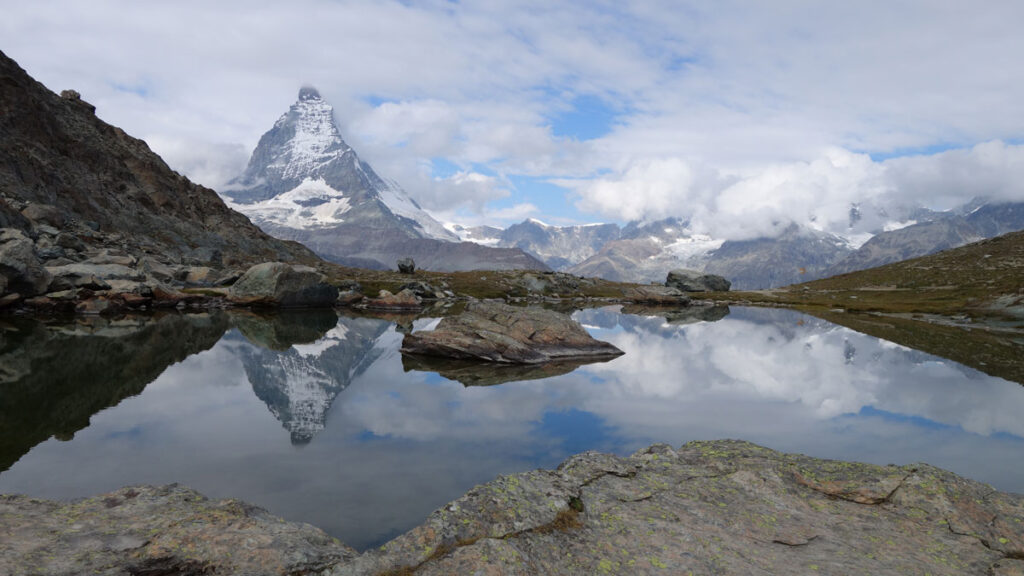When oceanic plates end their time atop Earth by plunging into the mantle, they don’t die—they reincarnate. At high pressures and temperatures, their minerals morph into green pyroxene and red garnet characteristic of eclogite—a hallmark rock of Earth’s interior.
During these transformations, water exits the downgoing slab and heads upward into the overriding plate’s mantle. As these rocks experience crushing pressures, any preexisting porosity—the space between the minerals—might be smooshed. This is one reason why geologists must suspend disbelief to enjoy movies like The Core, in which giant, perfectly formed crystals grow into cavernous spaces deep underground.
However, professors Samuel Angiboust of Ecole Normale Supérieure of Lyon, France, and Tom Raimondo of the University of South Australia recently reported a curious finding from the western Italian Alps: a slice of former seafloor, subducted to great depths…and riddled with coin-sized holes sometimes filled with festive red and green eclogitic minerals. Though these holes, or vugs, are much smaller than the spacious chambers in the movie, they’re still a surprise. Their existence hints at fluids that once held these pockets open many tens of kilometers below Earth’s surface—the only place where these particular pyroxenes and garnets can grow. Moreover, by examining these minerals at scales comparable to the thickness of a human hair, Angiboust and Raimondo found that these pore spaces must be isolated to keep fluid imprisoned.
Hard Rocks
“I noticed the surface of the outcrop…was punctuated with hundreds of these little holes, and I wondered, ‘What the heck is this?’”
In 2009, Angiboust and a field partner were mapping eclogites off a trail in the European Alps. After a brief break, Angiboust reached down to pick up his pack. “I noticed the surface of the outcrop…was punctuated with hundreds of these little holes, and I wondered, ‘What the heck is this?’” But he didn’t think much of it until he was hiking farther north in Switzerland and came upon more vuggy eclogite (yes, “vuggy” is a technical term). Making this observation again forced him to consider why such a feature existed in the first place, he said.
Unfortunately, trying to collect these weird little holes proved problematic because eclogites are among the hardest rocks. A trusty rock hammer won’t do. Instead, Angiboust used an electric saw and battery supply to excise a mere 50 grams (about 0.1 pound) of rock. “It was the most difficult thing I’ve ever sampled,” he said.

Sluggish Elements
Growing on the walls of the vugs, Angiboust found, were large, faceted garnets atypical of garden-variety eclogite. When he showed Raimondo the samples, Raimondo was immediately intrigued and began to consider how to look at the minerals’ tree ring–like elemental zones. In particular, as garnets grow, they tend to record distinct changes in certain elements depending on what’s nearby—like a fluid—as well as whether other minerals are concurrently growing anew or falling apart, Raimondo explained. By mapping certain elements that are especially sluggish once they’re securely locked within a garnet, scientists can reconstruct a rock’s stepwise evolution, evidence of which is often erased or cryptically recorded.
According to Angiboust and Raimondo’s modeling, the medium in which the faceted garnets must have grown most likely came from water-rich fluids released by the breakdown of hydrous minerals like chlorite, lawsonite, and glaucophane. “The fluid doesn’t know where to go, and it gets collected within bubbles,” Angiboust said. Within these water-filled bubbles, pyroxene needles and the big garnets grew, recording the changing fluid chemistry as they experienced increasingly higher temperatures and pressures.
Cold and Fast
Mary Leech, a San Francisco State University professor whose research focuses on ultrahigh-pressure eclogites, has not observed these types of vugs. She explained that to find such voids filled with eclogitic minerals, she’d expect the rocks in which they’re preserved to be exceptionally strong and protected from deformation. This is, in fact, precisely the setting in which Angiboust has now twice observed the features.
“You notice what you’re looking for.”
“I’m convinced these are actually quite commonplace,” said Mark Cloos, a professor at the University of Texas at Austin who has found several examples of vugs filled with high-pressure minerals in his own studies in California. Once you know to look for the vugs, he said, “you notice what you’re looking for.”
Angiboust agreed, saying, “you can easily overlook something…because you don’t have your eyes trained.” Also, if the fluid has a chance to escape, he said, “the vug is going to collapse.” These reasons may explain why so few holey eclogites have been recorded.
Leech pointed out that the fluids required to keep the vugs open would also tend to drive chemical reactions that would convert the garnets and pyroxenes back into water-rich minerals as the eclogites returned to the surface.
The upward path of the minerals, then, should be either fast or cold, or both, said Esti Ukar, a research scientist at the Bureau of Economic Geology at the University of Texas at Austin who was not involved in this study. Rapid exhumation and relatively cold conditions, she explained, could conspire to minimize the extent of chemical reactions described by Leech.
Direct Measures
No matter how they got to the surface, the existence of holey eclogites hints at what rocks deep in the Earth might look like. Typical methods of investigating Earth’s interior that are used by geophysicists and experimental petrologists provide indirect inferences of deep Earth’s permeability—the degree to which pore spaces are connected.
“Trying to establish the permeability of [subducted] crust is really, really challenging to do,” said Raimondo. By piecing together all of these intricate, high-resolution records directly from samples that were so deeply buried, scientists can now extrapolate the permeability of otherwise concealed crust.
—Alka Tripathy-Lang (@DrAlkaTrip), Science Writer

